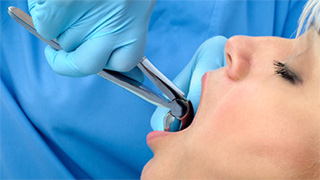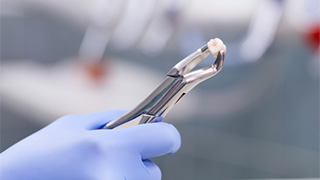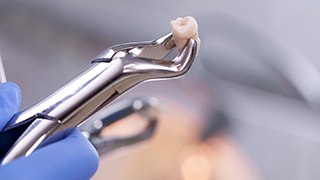Tooth Extractions – The Colony, Texas
Maintaining Oral Health for a Lifetime

The loss of even one tooth can dramatically impact oral health, and the Ridgepointe Dental team in The Colony usually works hard to help patients keep their natural smiles. In some cases, removing a tooth is actually the best way to preserve optimal oral health and function. While it’s rarely our first choice, our skilled dentists are happy to offer this advanced service to help patients keep their healthy bite. If you want to learn more about tooth extraction, call our dental office in The Colony to schedule a dental treatment consultation today. We’ll examine your smile, help you determine whether or not tooth extraction is necessary, and partner with you to create a customized treatment plan.
When are Tooth Extractions Indicated?

We will always do our utmost to help patients keep their natural teeth. However, in the following situations it may make more sense to remove teeth to improve your overall oral health and function:
- Severe tooth decay or damage that destroys too much of the tooth to be repaired
- To allow for easier tooth movement during orthodontic treatment where crowding is a main concern
- To ensure long-term success prior to the design and placement of a partial or full denture
- When primary teeth don’t fall out on their own
- When a tooth is impacted, unable to erupt
- Wisdom teeth, third molars, are often removed due to crowding or impaction
How are Teeth Removed?

Teeth are usually removed by pulling or surgical extraction. Pulling a tooth is only possible when it has fully emerged from the gum line. We numb the area around the tooth. Then, a clasping tool is used to shift the tooth until it breaks free from the gum line. When pulling isn’t possible, we will surgically remove the tooth. This may be as simple as making an incision in the gum line to reveal more of the tooth, but it can also involve drilling into bone tissue or breaking the tooth into smaller sections. Each person’s situation is unique, and before we begin your extraction procedure, we will carefully plan out every detail to ensure your comfort.
What Happens After Tooth Extraction?

Following your tooth removal, we’ll provide you with a specific treatment plan to care for your smile as you recover. Our goals are to keep you comfortable and avoid complications, so we’ll outline a pain management plan utilizing prescription and/or over the counter medications. You can also use ice packs to reduce swelling, slow bleeding, and decrease pain. Additionally, we’ll give you specific instructions for your oral hygiene routine, including when and how to change out your gauze, caring for your remaining healthy tooth structures, and warning signs potential health concerns. We can also help you plan to introduce a range of foods to your diet as the treatment site heals. You should contact us right away if you notice any of the following issues:
- Increasing pain rather than diminishing pain after the first two days
- Sensitivity near the surgical site
- Heat, redness, or swelling around the surgical site
- Bleeding that doesn’t stop after the first two days
Understanding the Cost of Tooth Extractions

If you’re at all worried about the cost of your tooth extraction, please know that our dental team near The Colony is here to help! At your initial consultation, we will learn about any symptoms you’re experiencing, ask you a few questions about your dental history, and complete a comprehensive oral exam. From there, we can determine if a tooth extraction is necessary. If it is, then we will solidify the details of your treatment plan, provide you with an estimate of the cost, and answer any questions you have.
Factors That Can Affect Tooth Extraction Cost

We mentioned above that we will solidify the details of your treatment plan and then provide you with an estimate of the cost. That’s because we need to determine a few things in order to give you an accurate number, including:
- How many teeth need to be extracted
- If any other restorative treatments are needed, like gum disease therapy
- The type of tooth that’s being extracted
- Whether a simple or surgical extraction is necessary
- The type of tooth-replacement solution you choose (i.e., dental bridge, denture, dental implant)
Does Dental Insurance Cover Tooth Extractions?

Since tooth extractions are considered major dental procedures, dental insurance providers usually cover around 50% of the cost. That said, there are several things that will impact if that’s the case for you, including if your plan has red tape, like waiting periods. That’s why it’s always a good idea to dedicate some time to reviewing the fine print on yours and reaching out to your provider if you have any questions. You’re more than welcome to ask our team at Ridgepointe Dental for assistance as well since we have lots of experience navigating the ins and outs of dental insurance benefits.
How to Make Tooth Extractions Affordable

But what if you don’t have dental insurance? Does that mean you have no choice but to pay for the cost of your tooth extraction in one lump sum? Fortunately, the answer is “no.” In addition to offering our patients periodic special offers in an effort to make preventive, restorative, and cosmetic dentistry more affordable, we welcome CareCredit flexible financing. This financial solution allows you to break down the cost of your care into smaller, more manageable monthly chunks. Some of their payment plans come with little-to-no interest attached too, which helps keep the price affordable over time.
Tooth Extraction FAQs

Even if you know it’s the best choice for your oral health, you might still be nervous about having a tooth extraction done – quite understandably so. Dr. Amos always loves answering his patients’ questions about dentistry, especially when it means helping them make the right decisions about their oral health. Check to see if your personal concerns are answered below, and feel free to reach out to our office if you have any other questions about the process.
How Much Discomfort Should I Expect?
Your mouth will be numbed during the procedure, and sedation will be applied if deemed necessary. That means there will be little to no pain during the extraction itself. Once the medication has worn off, however, some slight discomfort will be felt around the extraction site. You’ll be able to take over-the-counter pain relievers to help soothe your pain, although sometimes you’ll receive a prescription instead. If the discomfort starts to grow more severe over time, or if it doesn’t go away as expected, you need to get in touch with Dr. Amos as soon as possible for a follow-up examination.
How Long Will the Bleeding Last?
Most of the bleeding will occur immediately after the tooth is removed. You’ll be given a piece of gauze to bite down on, putting pressure on the wound until the bleeding stops. This should only take a few minutes. It’s not unusual for a little blood to ooze out of the site for up to 24 hours after the extraction, so don’t be alarmed if this happens.
A protective clot will form in the socket to completely stop the bleeding. If this clot becomes dislodged, the result is a very uncomfortable “dry socket.” To avoid this condition, follow our directions carefully and avoid behaviors that might disturb the clot, such as sucking on a straw.
How Long Will It Take for the Mouth to Heal?
That depends on which tooth needed to be pulled as well as the condition it was in when it was removed. Front teeth don’t have as many roots as back teeth, which means less gum tissue needs to heal after an extraction. Nutrition, oral hygiene, and smoking habits can all influence your mouth’s ability to heal after surgery. Normally, though, the initial healing process will take about one to two weeks, although it can take up to four months for the underlying bone to fully restore itself.
What’s the Risk of a Complication Occurring?
Your biggest concern after an extraction is likely to be an infection. If you don’t keep the extraction site clean, bacteria might have the opportunity to enter the wound, causing inflammation that can lead to serious issues later down the line. Also, if a dry socket occurs, the healing process will be disrupted, and you’ll experience quite a bit of additional discomfort. You can protect yourself from these complications with good oral habits, but it’s important to reach out as soon as you start experiencing troublesome symptoms such as swelling, nausea, excessive pain, and a mouth filling with blood.
